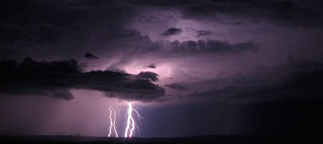We can expect thundershowers, possibly with heavy rain, possibly with hail, every few days in the afternoon or late afternoon on our Outdoor Club summer Yosemite and Grand Teton National Parks trips, or other mountain trips.
We check the local weather report each morning when we get up, and again as we start a paddle, hike or activity. We have occasionally decided to not be out on the water and we do other activities instead. (Once we were at a launch point in Grand Teton National park, with the trailer full of kayaks, and a park Ranger drove by, stopped and asked us if we were planning to launch. She was pleased to hear us listening to the weather report radio and telling her that we had already decided to not paddle that day, but were talking about alternate plans.)
Bring decent rain gear (you’ll be happier and dryer with a waterproof hooded rain jacket and pants instead of a rain poncho that lets water drip on your legs)
and a tent with a full rain fly. You can get a set of rain pants/jacket at a hardware store then Improve your inexpensive rain gear. If you’ve never packed for a trip with expected interesting weather, take a look at Snow or rain camp must-haves .
Hikes to peaks need to start early, so you can get to the top and get back down before the afternoon clouds build up.
The National Weather Service warns:
“Myth: If it’s not raining or there aren’t clouds overhead, you’re safe from lightning.
Fact: Lightning often strikes more than three miles from the center of the thunderstorm, far outside the rain or thunderstorm cloud. “Bolts from the blue” can strike 10-15 miles from the thunderstorm.
The National Weather Service advises:
- Plan ahead, that includes knowing where you’ll go for safety.
- Listen to the forecast.
- Cancel or postpone activities if thunderstorms are in the forecast.
- Monitor weather conditions.
- Take action early so you have time to get to a safe place.
- Get inside a substantial building or hard-topped metal vehicle before threatening weather arrives.
- If you hear thunder, get to the safe place immediately.
You are never fully safe outside:
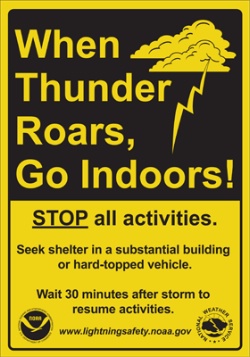
The Park service warns: “There is no safe place outside during a storm with lightning; the best you can do is to reduce your chances of being struck by lightning (the only truly safe option is being inside a vehicle with a hard top or a building).
Learn about the seasonal weather patterns of the area in which you are plan to recreate. In Yosemite, thunderstorms most commonly develop in the afternoon; plan to reach the summit or high point of your trip each day by noon.
Check the most up-to-date weather forecast possible before setting off.
Pay attention to shifting weather conditions: low, dark, and fast-moving clouds; an increase in wind speed; a drop in temperature; and the sound of thunder are all signs of changing weather.
Be prepared and willing to turn around at any time: at the first sound of thunder, immediately descend from exposed summits and mountaintops, high ridges, and open granite slabs to lower terrain.
NOAA says:
“If you can’t get inside a substantial building or hard-topped metal vehicle, you can’t be safe. While there may be nothing you can do to lower your risk significantly, there are things you should avoid which would actually increase the risk of being struck. Those include:
- Avoid open areas.
- Don’t be or be near the tallest objects in the area.
- Don’t shelter under tall or isolated trees.
- In the woods, put as much distance between you and any tree.
- If in a group, spread out so that you increase the chances for survivors who could
come to the aid of any victims from a lightning strike.”
The National Park Service has said
Do NOT position yourself next to a tall, solitary tree or a metal trail sign.
Do NOT take shelter under—or sit up against—exposed, overhanging rock.
In a forested area, if you are in a group, spread out but remain within earshot of one another.
Assuming the lightning position is an option: it is a low squat, with feet together (to reduce the effects of ground current) and arms tucked.
National Outdoor Leadership School (NOLS) backcountry lightning safety guidelines describe this crouching position:
“This position includes squatting (or sitting) and balling up so you are as low as possible without getting prone. Wrap your arms around your legs, both to offer a safer path than your torso for electrons to flow from the ground, and to add enough comfort that you will choose to hold the position longer. Close your eyes…
Keep your feet together so you don’t create potential for current to flow in one foot and out the other … current may spontaneously trigger your leg muscles to jump while in the lightning position, so take care to avoid being near hazards when you drop into this position.”
The park service offers this drawing of the lightning position:
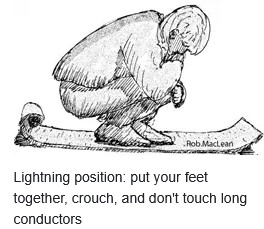
From Grand Canyon National park:
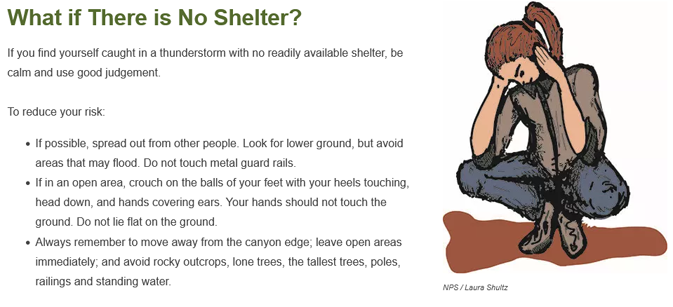
and see the Grand Canyon National Park lightning safety advice page
https://www.nps.gov/grca/planyourvisit/lightning-danger.htm
Read more advice at:
https://www.weather.gov/safety/lightning-safety
https://www.weather.gov/media/safety/backcountry_lightning.pdf has this drawing of the lightning safety position:
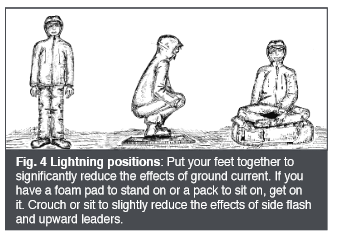
Crouch on something insulating if possible, such as your ensolite sleeping pad, or climbing rope. Even dry moss or grass or a snow patch is better than bare rock. Especially if you have to sit instead of crouch, get some insulation under your buttocks.
Do not lie flat on the ground.
Get metal objects away from you (they don’t attract lightning but they carry induced currents which, although they are small, can add to ground currents and make the difference between getting zapped a little and getting zapped too much or burnt. A woman’s watch was burned to her wrist in one instance.)
Stay out of small depressions. Pick a slight rise instead. Not in standing water or a puddle.
Hey! Spread out your group so you aren’t all hit at once. (NOLS says 50 feet apart. The Red Cross says “spread groups out wide with about 100 feet or more between individuals. Keep everyone in sight if possible.”)
But mostly, pick a place quickly and get down, and stay down.
Coaches: stay away from metal bleachers, railings, backstops and fences. Lightning can travel long distances through metal. Avoid dugouts, sheds. If a sturdy, substantial building is not nearby, a hard topped metal vehicle with the windows closed offers good protection.
If in a building , don’t take a shower or use a sink, including washing your hands or laundry or dishes. Don’t talk on a land line phone.
You can use remote controls, but don’t touch electrical equipment such as computers, TVs or cords.
Do not sit or lie on concrete floors or lean against concrete walls or touch metal doors.
https://www.weather.gov/safety/lightning-indoors warns: “Lightning generates electric surges that can damage electronic equipment some distance from the actual strike. Typical surge protectors will not protect equipment from a lightning strike. Do not unplug equipment during a thunderstorm as there is a risk you could be struck.”
From Aquatics International:
“Over the years there have been documented lightning-related fatalities to persons talking on a corded phone (including a cell phone that was plugged in and charging) or while using a computer plugged into an outlet. Because of this, the NWS” (National Weather Service) “recommends people stay off corded phones, computers and other electrical equipment that makes direct contact with electricity.”
https://www.aquaticsintl.com/facilities/management-operators/a-bolt-and-a-clap-part-2-of-the-survey-on-lightning-and-aquatics-facilities_o
From Accuweather:
“You hear thunder and head indoors — great way to stay safe. But now, the landline phone . . . is ringing. Should anyone answer it? No, let the answering machine pick it up.
People have been shocked by lightning when talking on the phone. One person was killed in Kincaid, Illinois in 1981 when lightning struck an outside telephone line and traveled to the house via a phone line, causing the phone to explode.”
Don’t use your iPod (more on that below.)
Weather.Gov tells us: “Thunder is the sound made by a flash of lightning. As lightning passes through the air it heats the air quickly. This causes the air to expand rapidly and creates the sound wave we hear as thunder. Normally, you can hear thunder about 10 miles from a lightning strike. Since lightning can strike outward 10 miles from a thunderstorm, if you hear thunder, you are likely within striking distance from the storm. ” https://www.weather.gov/safety/lightning-science-overview
Lightning moves at the speed of light: very, very fast. The sound of thunder moves a little slower (yup, at the speed of sound). If you count the seconds between when you see the light flash and when you hear the thunder and divide by 5 you will know about how far away in miles the lightning hits are. (For example, ten seconds would be about 2 miles.) BUT thunder is only heard up to about 10 or 15 miles away.
Some groups recommend using this flash to bang / bolt to clap method of deciding how far away a thunderstorm is to decide when to go to safety, but it is not recommended by most weather experts who say to get to safety IMMEDIATELY whenever you hear thunder (or even before you hear thunder when the clouds are building up and look ominous).
Lightning has hit from a storm 5 to more than 15 miles away, so you can be hit by lightning in an area where it is actually not raining. People have been hit after a storm has “passed.”
There is really no such thing as heat lightning, it is just regular lightning far enough away that you did not hear the thunder that accompanied the lightning.
“Thunderstorms are among the smallest and shortest-lived forms of hazardous weather in the U.S. They’re typically five to 15 miles in diameter and last 30 minutes to a few hours.” according to Bill Bunting, deputy director at the federal Storm Prediction Center, as quoted in the New York Times.

If someone gets hit by lightning, or even nearly hit, they may be thrown a distance, so if they need ventilations (also known as rescue breathing and/or artificial respiration) you’ll need to treat them as a spinal injury and use a modified jaw thrust rather than head-tilt chin-lift. If you are out in the wilderness, away from quick EMS help, you might need to give ventilations for a whole hour or even longer. Don’t give up if they still have a pulse. NO, you won’t get electrocuted by touching someone who was hit by lightning.
Medicine for Mountaineering says:
“Clearly the emergency treatment for a lightning victim consists of immediate, and sometimes prolonged, artificial respiration. (Cardiac resuscitation should be given also, if needed, but the heart most often resumes beating on it’s own.) Over seventy percent of the persons struck by lightning have enough disruption of brain function to lose consciousness. Recovery of enough function to resume breathing commonly takes as long as twenty to thirty minutes, and occasionally takes hours.
If more than one person has been struck by lightning, which commonly occurs, attention should be directed first to the ones who are lying still, not breathing and appear dead. Those who are groaning or rolling around, although unconscious, are breathing and do not require immediate attention.”
You can reassure anyone who might have lost vision or has some paralysis that it is common with a lightning hit, and is usually temporary. Short term memory may be lost for a few days.
At the National Weather Service / NOAA (National Oceanic and Atmospheric Administration) https://www.weather.gov/safety/lightning-victims
we read:
“Medical Aspects of Lightning
There is little you can do to substantially reduce your risk if you are outside in a thunderstorm. The only completely safe action is to get inside a safe building or vehicle.
–What are the Medical Symptoms?
Lightning is primarily an injury to the nervous system, often with brain injury and nerve injury. Serious burns seldom occur. People who do not suffer cardiac arrest at the time of the incident may experience lesser symptoms, which often clear over a few days:
• Muscle soreness
• Headache, nausea, stomach upset and other post-concussion types of symptoms
• Mild confusion, memory slowness or mental clouding
• Dizziness, balance problems
Longer Term Problems
Most survivors experience only some of the symptoms below:
• Problems coding new information and accessing old information
• Problems multitasking
• Slower reaction time
• Distractibility
• Irritability and personality change
• Inattentiveness or forgetfulness
• Headaches which do not resolve with usual OTC meds
• Chronic pain from nerve injury
• Ringing in the ears and dizziness or balance problems
• Difficulty sleeping, sometimes sleeping excessively at first and later only two or three hours at a time
Delayed Symptoms
• Personality changes/self-isolation
• Irritability and embarrassment because they can’t remember people, job responsibilities and key information
• Difficulty carrying on a conversation
• Depression
• Chronic pain and headaches
Friends, family and co-workers who see the same external person may not understand why the survivor is so different. Friends may stop coming by or asking them to participate in activities or survivors may self-isolate out of embarrassment or irritability. As with other disabilities, families who are not committed to each other are more likely to break up.”
Five Ways Lightning Strikes People (direct strike, side flash, ground current, conduction, streamers) : https://www.weather.gov/safety/lightning-struck
Lightning strikes in the last 24 hours are recorded at:
https://www.lightningmaps.org/blitzortung/america/index.php?lang=en
https://www.accuweather.com/en/us/national/severe-weather-maps
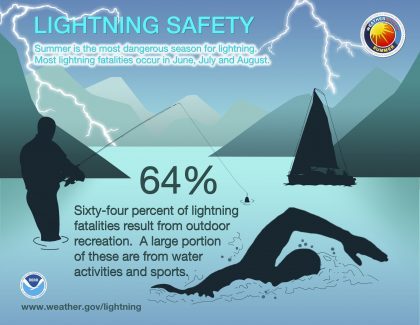
We can find the answer from the Charolotte observer:
GLAD YOU ASKED
Why don’t fish get fried by lightning?
JEFF ELDER
“Q. They always urge you to get out of the water when a thunderstorm begins. Why doesn’t lightning kill fish? — Mel Helms, Charlotte
“…The best answer to Mel’s question we found comes from Don MacGorman, a physicist at the National Severe Storms Laboratory in Norman, Okla. When Sciencenetlinks.com asked him why fish don’t get fried by lightning, Don said it’s probably because they’re underwater.
“Basically lightning stays more on the surface of the water rather than penetrating it. That’s because water is a reasonably good conductor, and a good conductor keeps most of the current on the surface,” he said.
So, when lightning hits the water, the current zips across the surface in all directions. And if you’re swimming anywhere in the vicinity, it’ll probably zap you. But below the surface, most of the electricity is neutralized, and the fish are generally spared. Some fish underwater near the strike are probably hurt or killed by electricity that penetrates to some extent…
The National Weather Service sends out these reminders:
• You SHOULD get out of the water right away.
• Outdoors is the worst place to be during a thunderstorm. Quickly move indoors or into a hard-topped vehicle and stay there until well after lightning stops.
• If you’re outside, make yourself the lowest point in the area. Lightning hits the tallest object. Crouch if you are in an exposed area. Stay away from trees.
• Don’t huddle in a group.”
From an Associated Press article,
Lightning Strikes Reported by iPod Users
“Listen to an iPod during a storm and you may get more than electrifying tunes. A Canadian jogger suffered wishbone-shaped chest and neck burns, ruptured eardrums and a broken jaw when lightning traveled through his music player’s wires.
Last summer, a Colorado teen ended up with similar injuries when lightning struck nearby as he was listening to his iPod while mowing the lawn.
Emergency physicians report treating other patients with burns from freak accidents while using personal electronic devices such as beepers, Walkman players and laptop computers outdoors during storms.
Michael Utley, a former stockbroker from West Yarmouth, Mass., who survived being struck by lightning while golfing, has tracked 13 cases since 2004 of people hit while talking on cell phones…
Contrary to some urban legends and media reports, electronic devices don’t attract lightning the way a tall tree or a lightning rod does.
“It’s going to hit where it’s going to hit, but once it contacts metal, the metal conducts the electricity,” said Dr. Mary Ann Cooper of the American College of Emergency Physicians and an ER doctor at University of Illinois Medical Center at Chicago.
When lightning jumps from a nearby object to a person, it often flashes over the skin. But metal in electronic devices — or metal jewelry or coins in a pocket — can cause contact burns and exacerbate the damage.
A spokeswoman for Apple Inc., the maker of iPods, declined to comment. Packaging for iPods and some other music players do include warnings against using them in the rain.
Lightning strikes can occur even if a storm is many miles away, so lightning safety experts have been pushing the slogan “When thunder roars, go indoors,” said Cooper.”
Read more at:
New England Journal of Medicine:
Thunderstorms and iPods — Not a Good iDea
http://content.nejm.org/cgi/content/full/357/2/198
which includes a case of a jogger in a thunderstorm listening to his IPod, who suffered a broken jaw and a severe hearing deficit due to both of his tympanic membranes being ruptured. The IPod did not increase the chances of being struck, but the “combination of sweat and metal earphones directed the current to, and through, the patients’ head.”
see also: Cell phones in the wilderness which has advice on how/when to use a cell phone to contact 911 in the wilderness and a warning about interference between cell phones, iPods and avalanche beacons.
From the National Park Service Morning Report of Thursday, August 3, 2000
Yellowstone NP (WY) – Lightning Strike with Multiple Injuries
Park dispatch received a 911 call at 10:45 p.m. on August 1st reporting that lightning had hit a large lodgepole pine between two campsites at Bridge Bay and that 13 campers had been injured. A ranger in the area was on scene within minutes. Three of eight people in tents at the campsite located closest to the lightning strike were transported to Lake Hospital and treated for minor injuries; two of five campers who had been sitting by their campfire at a second site were treated at the scene and refused additional medical attention. One said that he was knocked off his feet by the strike. All 13 reported that they felt electricity from the lightning run through their bodies. The entire rear and side windows of a vehicle parked near one of the campsites were blown out, and a 40-foot section of the tree landed inches away from a tent occupied by three visitors. Additional debris from the strike was scattered in a 50-foot radius around the point where the lightning hit.
3 bolts jolt climbers
Caught in a storm high on the Grand Teton, a team endures trial by fire and ice.
By Whitney Royster
“Lightning bolts near the summit of the Grand Teton struck three climbers three times Aug. 21, singeing jackets and skin as the men hunkered down and prayed for their lives.
Dave Schwietert, 25, Fletcher Brinkerhoff, 28, and Mike Gauthier, 33, were within 200 feet of the 13,770-foot summit, tied to one another with a rope, when a storm rolled in. Schwietert said he saw the first charge strike.
“I see this blue-green ball coming down the rope at me,” Schwietert said. “It was like the size of a beach ball. Then boom! It hit….
…”It went from Fletcher to Mike to me down the rope,” Schwietert said.
The charge ran through the whole body, Brinkerhoff and Schwietert said.
“When you get shocked from an outlet, usually it shocks you to your shoulder and it really hurts,” Brinkerhoff said. “This was more intense and went through the whole body.”
Gauthier said the sensation was of being electrocuted.
“I felt as though someone was kicking me in the back of my head really hard,” he said.
Schwietert hid in the nook with his partners, and Gauthier told him to take off caribiners and other metal objects.
“We were scrambling to get it all off,” Schwietert said. “We’re thinking we’re going to hunker down and wait it out.”
Amid 35-mph winds and hail and rain came another blast. “Out of nowhere we get a second hit,” Schwietert said
The bolt again hit a nearby rock, then bounced to Brinkerhoff, Gauthier, then Schwietert.
“This one was bigger,” Schwietert said. “It actually lifted us. That one spooked us bad. We weren’t touching each other or touching the rock.”
Gauthier said the novelty of adventure evaporated.
“The first one got my attention, the second and third one instilled the fear,” he said.
Schwietert yelled to his buddies, “So much for what they say about getting hit by lightning twice!” Then he sat, held his head in his hands and prayed.
“We were trying to wait this thing out,” he said. “I kept moving my limbs to make sure I was still okay.”
Brinkerhoff said the second strike changed the situation.
“We realized it was very serious, that this was still the beginning of the storm cell,” he said. “It was kind of one of those things where you think, ‘There’s a chance I’m going to live, and there’s also a very good chance that we won’t.’ It was very serious there for a while.”
Brinkerhoff said he thought he smelled his hair burning after the second hit.
The climbers talked about moving from their nook but decided higher was too exposed and lower was too risky. Then the third bolt hit.
“It was the same feeling,” Schwietert said. “We were still curled up shaking because of the weather and the cold.”
Schwietert said the ordeal lasted about 30 minutes. The team scurried to the top, then began a descent down the Owen-Spalding route.
Once they reached the Lower Saddle, Brinkerhoff discovered what looked like a small cigarette burn on his jacket. The nylon burn was likely the smell after the second strike, Schwietert said. The bolt went through five layers of clothing.
Brinkerhoff then found a burn on the top of his left shoulder.
Schwietert said when he took his gloves off at the saddle, his hands were purple and his veins were prominent.
“I think it was from the first strike when my hands were on the rope,” he said.
In all, Brinkerhoff had four burns on his body: one on his shoulder, one on each ankle and one on his left shin. Gauthier had one burn on his back by his ribs that is more of a streak, Schwietert said.
“Since Fletcher was the highest, I think he took the brunt,” he said.
Schwietert said the incident won’t stop him from climbing but gave him a sense of his luck.
“That was my eight lives,” he said.”
“A total of 13 people had been flown on and off the upper reaches of the mountain in the span of three hours. The rangers had proved just how good the search and rescue safety net can get when a highly competent, well-supported staff stands by waiting to save lives. Unfortunately, as crowding increases in America’s iconic landscapes, such emergencies inevitably become more common. The rangers worry that successful missions like this one may encourage climbers and hikers to take unnecessary risks.”
http://www.abovecalifornia.com/lib/index.php
try these chapters:
X A WIND-STORM IN THE FORESTS
XII SIERRA THUNDER-STORMS



According to FEMA:
“Severe Thunderstorm Watches and Warnings
A severe thunderstorm watch is issued by the National Weather Service when the weather conditions are such that a severe thunderstorm (damaging winds 58 miles per hour or more, or hail three-fourths of an inch in diameter or greater) is likely to develop. This is the time to locate a safe place in the home and tell family members to watch the sky and listen to the radio or television for more information.
A severe thunderstorm warning is issued when a severe thunderstorm has been sighted or indicated by weather radar. At this point, the danger is very serious and everyone should go to a safe place, turn on a battery-operated radio or television, and wait for the “all clear” by the authorities.”
DURING
If indoors:
· Secure outdoor objects such as lawn furniture that could blow away or cause damage or injury. Take light objects inside.
· Shutter windows securely and brace outside doors.
· Listen to a battery operated radio or television for the latest storm information.
· Do not handle any electrical equipment or telephones because lightning could follow the wire.
Television sets are particularly dangerous at this time.
· Avoid bathtubs, water faucets, and sinks because metal pipes can transmit electricity.
If outdoors:
· Attempt to get into a building or car.
· If no structure is available, get to an open space an squat low to the ground as quickly as possible. (If in the woods, find an area protected by low clump of trees–never stand underneath a single large tree in the open.) Be aware of the potential for flooding in low-lying areas.
· crouch with hands on knees.
· Avoid tall structures such as towers, tall trees, fences, telephone lines, or power lines.
· Stay away from natural lightning rods such as golf clubs, tractors, fishing rods, bicycles, or camping equipment.
· Stay from rivers, lakes, or other bodies of water.
· If you are isolated in a level field or prairie and you feel your hair stand on end (which indicates that lightning is about to strike), bend forward, putting your hands on your knees. A position with feet together and crouching while removing all metal objects is recommended.
Do not lie flat on the ground.
If in a car:
· Pull safely onto the shoulder of the road away from any trees that could fall on the vehicle.
· Stay in the car and turn on the emergency flashers until the heavy rains subside.
· Avoid flooded roadways.
Estimating the Distance from a Thunderstorm
Because light travels much faster than sound, lightning flashes can be seen long before the resulting thunder is heard. Estimate the number of miles you are from a thunderstorm by counting the number of seconds between a flash of lightning and the next clap of thunder. Divide this number by five.
Important: You are in danger from lightning if you can hear thunder. Knowing how far away a storm is does not mean that you’re in danger only when the storm is overhead.
Hail
Hail is produced by many strong thunderstorms. Hail can be smaller than a pea or as large as a softball and can be very destructive to plants and crops. In a hailstorm, take cover immediately. Pets and livestock are particularly vulnerable to hail, so bring animals into a shelter.
AFTER
Check for injuries.
A person who has been struck by lightning does not carry an electrical charge that can shock other people. If the victim is burned, provide first aid and call emergency medical assistance immediately. Look for burns where lightning entered and exited the body. If the strike cause the victim’s heart and breathing to stop, give cardiopulmonary resuscitation (CPR) until medical professionals arrive and take over.
Remember to help your neighbors who may require special assistance–infants, elderly people, and people with disabilities.
Report downed utility wires.
Drive only if necessary. Debris and washed-out roads may make driving dangerous.”

________________________________________
see also:
Lightning Risk Management for Backcountry Campers and Hikers
https://www.weather.gov/media/owlie/backcountry_lightning.pdf
http://www.nps.gov/yose/planyourvisit/hikingsafety.htm
http://www.nps.gov/yose/planyourvisit/climbing_safety.htm
Enhance your hike by reading:
The day hike gear section at Camping equipment checklist
 You can’t always expect a helicopter rescue
You can’t always expect a helicopter rescue
Safe distances from wildlife includes reasons to stay away from even friendly seeming animals in parks and charts and photos to better be able to determine and visualize how far away from wildlife you need to stay to be safe (and obey laws that do have penalties).
The use of cell phones for photography (with or without a selfie stick) has made preventable injury or even death by selfie common They were just taking a selfie . . .
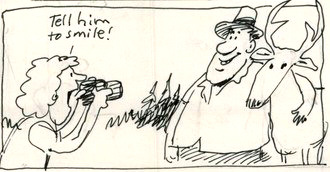
Can a person who is prescribed an epi-pen risk going into the wilderness? and some sting prevention notes are at: Anaphylaxis quick facts
Hiking Advice has hot weather hiking advice, hiking logistics and the answer to the question: When is the best time of day to cross a mountain stream?
Enhance your drive to your next adventure: Road trip advice and etiquette
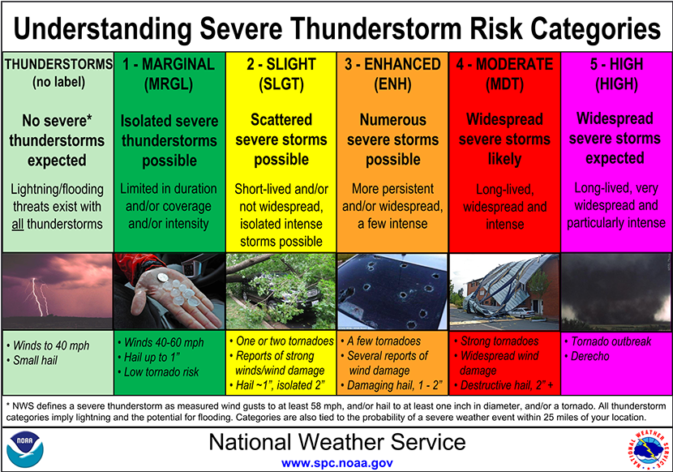

How many people are killed by lightning each year in the United States?
National Weather Service Lightning Fatalities in 20XX (by the year) https://www.weather.gov/safety/lightning-fatalities
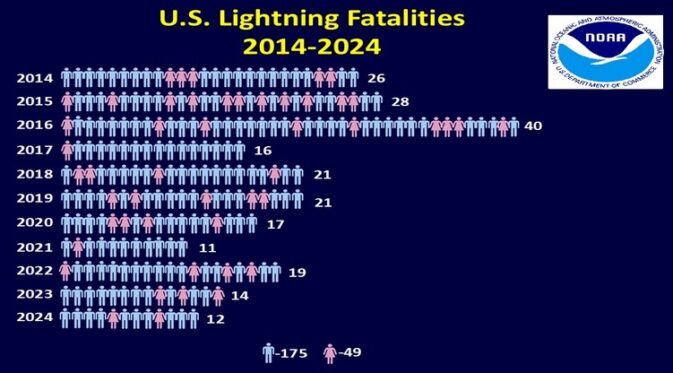
The author of this webpage, (written as a homework reading assignment for my students), does not give any warranty, expressed or implied, nor assume any legal liability or responsibility for the accuracy, completeness, or usefulness of any information, product, or process included in this website or at websites linked to or from it. Users of information from this website assume all liability arising from such use.

